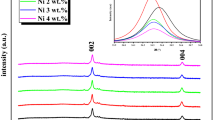Abstract
Pb(Zr0.52Ti0.48)O3 (PZT) thin films on copper foils were fabricated via rf magnetron sputtering and ex situ crystallized in a forming gas atmosphere. The PZT/Cu system is interesting due to the low oxygen partial pressure (pO2) required during crystallization to prevent Cu oxidation, as well as the mismatch of substrate and film coefficients of thermal expansion. The formation of a Cu2O interlayer at pO2 levels not thermodynamically predicted suggests that the film and substrate cannot be thought of as being in equilibrium. It was expected that thicker films would provide a stronger barrier to oxygen diffusion from the ambient to the substrate, but instead Cu2O formation was found to increase with PZT film thickness. Therefore, the PZT film likely plays an active role in substrate oxidation, perhaps as a source of oxygen. Cu oxidation was significantly minimized by wrapping the films in a sacrificial copper envelope during crystallization. This likely resulted in a gettering of oxygen, which buffered the local pO2 inside the envelope near the—Cu–Cu2O thermodynamic equilibrium curve during heating. Two distinct mechanisms may be responsible for the oxidation of the Cu substrate. These can explain the film thickness and crystallization temperature dependence of the Cu2O interlayer formation, as well as justify the use of a Cu envelope. The dielectric response and hysteresis are shown for samples with varying amounts of the Cu2O interlayer. A dielectric relaxation near 1 kHz was correlated to the presence of the interlayer.






Similar content being viewed by others
References
Piticescu RM, Mitoseriu L, Viviani M, Moagar Poladian V (2005) Preparation and characterisation of Pb(Zr0.52Ti0.48)0.975Nb0.025O3 ceramics: modelling the device. J Eur Ceram Soc 25(12):2491–2494. doi:10.1016/j.jeurceramsoc.2005.03.088
Gebhardt S, Seffner L, Schlenkrich F, Schonecker A (2007) PZT thick films for sensor and actuator applications. J Eur Ceram Soc 27(13–15):4177–4180. doi:10.1016/j.jeurceramsoc.2007.02.122
Muralt P (2000) PZT thin films for microsensors and actuators: where do we stand? IEEE Trans Ultrason Ferroelectr Freq Control 47(4):903–915. doi:10.1109/58.852073
Burn I, Maher GH (1975) High resistivity BaTiO3 ceramics sintered in CO–CO2 atmospheres. J Mater Sci 10(4):633–640. doi:10.1007/BF00566571
Buessem WR, Prokopowicz TI (1976) Electrode and materials problems in ceramic capacitors. Ferroelectrics 10(1):225–230. doi:10.1080/00150197608241984
Ogawa T, Saitoh S, Sugiyama O, Kondoh A, Mochizuka T, Masuda H (1994) Sol–gel barium titanate thin films on nickel alloy electrodes. In: Proceedings of the 9th IEEE international symposium on applications of ferroelectrics, pp 399–403. doi:10.1109/ISAF.1994.522386
Maria JP, Cheek K, Streiffer S, Kim SH, Dunn G, Kingon AI (2001) Lead zirconate titanate thin films on base-metal foils: an approach for embedded high-permittivity passive components. J Am Ceram Soc 84(10):2436–2438. doi:10.1111/j.1151-2916.2001.tb01029.x
Losego MD, Jimison LH, Ihlefeld JF, Maria JP (2005) Ferroelectric response from lead zirconate titanate thin films prepared directly on low-resistivity copper substrates. Appl Phys Lett 86:172906. doi:10.1063/1.1919388
Kingon AI, Srinivasan S (2005) Lead zirconate titanate thin films directly on copper electrodes for ferroelectric, dielectric and piezoelectric applications. Nat Mater 4:233–237. doi:10.1038/nmat1334
Ma B, Chao S, Narayanan M, Liu S, Tong S, Koritala RE, Balachandran U (2013) Dense PLZT films grown on nickel substrates by PVP-modified sol-gel method. J Mater Sci 48:1180–1185. doi:10.1007/s10853-012-6857-5
Damjanovic D (1998) Ferroelectric, dielectric and piezoelectric properties of ferroelectric thin films and ceramics. Rep Prog Phys. doi:10.1088/0034-4885/61/9/002
Dubois MA, Muralt P (1999) Measurement of the effective transverse piezoelectric coefficient e31, f of AlN and Pb(Zr x , Ti1-x)O3 thin films. Sens Actuators 77:106–112. doi:10.1016/S0924-4247(99)00070-9
Griggio F, Jesse S, Kumar A, Ovchinnikov O, Kim H, Jackson TN, Damjanovic D, Kalinin SV, Trolier-McKinstry S (2012) Substrate clamping effects on irreversible domain wall dynamics in lead zirconate titanate thin films. Phys Rev Lett 108:157604. doi:10.1103/PhysRevLett.108.157604
Kim T, Kingon AI, Maria JP, Croswell RT (2007) Lead zirconate titanate thin film capacitors on electroless nickel coated copper foils for embedded passive applications. Thin Solid Films 515:7331–7336. doi:10.1016/j.tsf.2007.02.085
Gaskell DR (2008) Introduction to the thermodynamics of materials, 5th edn. Taylor and Francis, New York
Alexander JH (1978) Monolithic ceramic capacitors. U.S. Patent Office 4089813, ITT Industries, Inc: New York
Akse JR (1986) Method for strengthening terminations on reduction fired multilayer capacitors. U.S. Patent Office 4571276, North American Philips Corp., New York
Losego MD, Ihlefeld JF, Maria JP (2008) Importance of solution chemistry in preparing sol–gel PZT thin films directly on copper surfaces. Chem Mater 20(1):303–307. doi:10.1021/cm070999q
Calderon V (2010) Design and implementation of a controlled pO2 system for annealing electroceramic thin films on flexible metallic substrates. Thesis, Oregon State University, Oregon
Brennecka GL, Parish CM, Tuttle BA, Brewer LN, Rodriguez MA (2008) Reversibility of the perovskite-to-fluorite phase transformation in lead-based thin and ultrathin films. Adv Mater 20(8):1407–1411. doi:10.1002/adma.200702442
Suchaneck G, Hubicka Z, Levin AA, Gunther S, Cada M, Dejneka A, Jastrabik L, Meyer DC, Schultheiss E, Gerlach G (2009) Recrystallization of the copper bottom electrode during complex oxide deposition onto Kapton films. In: Proceedings of the 18th IEEE international symposium on applications of ferroelectrics. doi:10.1109/ISAF.2009.5307558
White WB, Roy R (1964) Phase relations in the system lead-oxygen. J Am Ceram Soc 47(5):242–249. doi:10.1111/j.1151-2916.1964.tb14404.x
Ong RJ, Payne DA, Sottos NR (2005) Processing effects for integrated PZT: residual stress, thickness, and dielectric properties. J Am Ceram Soc 88(10):2839–2847. doi:10.1111/j.1551-2916.2005.00641.x
Wu A, Vilarinho PM, Srinivasan S, Kingon AI, Reaney IM, Woodward D, Ramos AR, Alves E (2006) Microstructural studies of PZT thick films on Cu foils. Acta Mater 54:3211–3220. doi:10.1016/j.actamat.2006.03.006
Acknowledgments
We gratefully acknowledge the U.S. Army Research Laboratory and specifically Dr. Ron Polcawich for directly supporting this research. We also acknowledge Hewlett-Packard for assistance with XPS measurements.
Author information
Authors and Affiliations
Corresponding author
Rights and permissions
About this article
Cite this article
Walenza-Slabe, J., Gibbons, B.J. Processing of rf-sputtered lead zirconate titanate thin films on copper foil substrates. J Mater Sci 50, 6420–6426 (2015). https://doi.org/10.1007/s10853-015-9196-5
Received:
Accepted:
Published:
Issue Date:
DOI: https://doi.org/10.1007/s10853-015-9196-5




